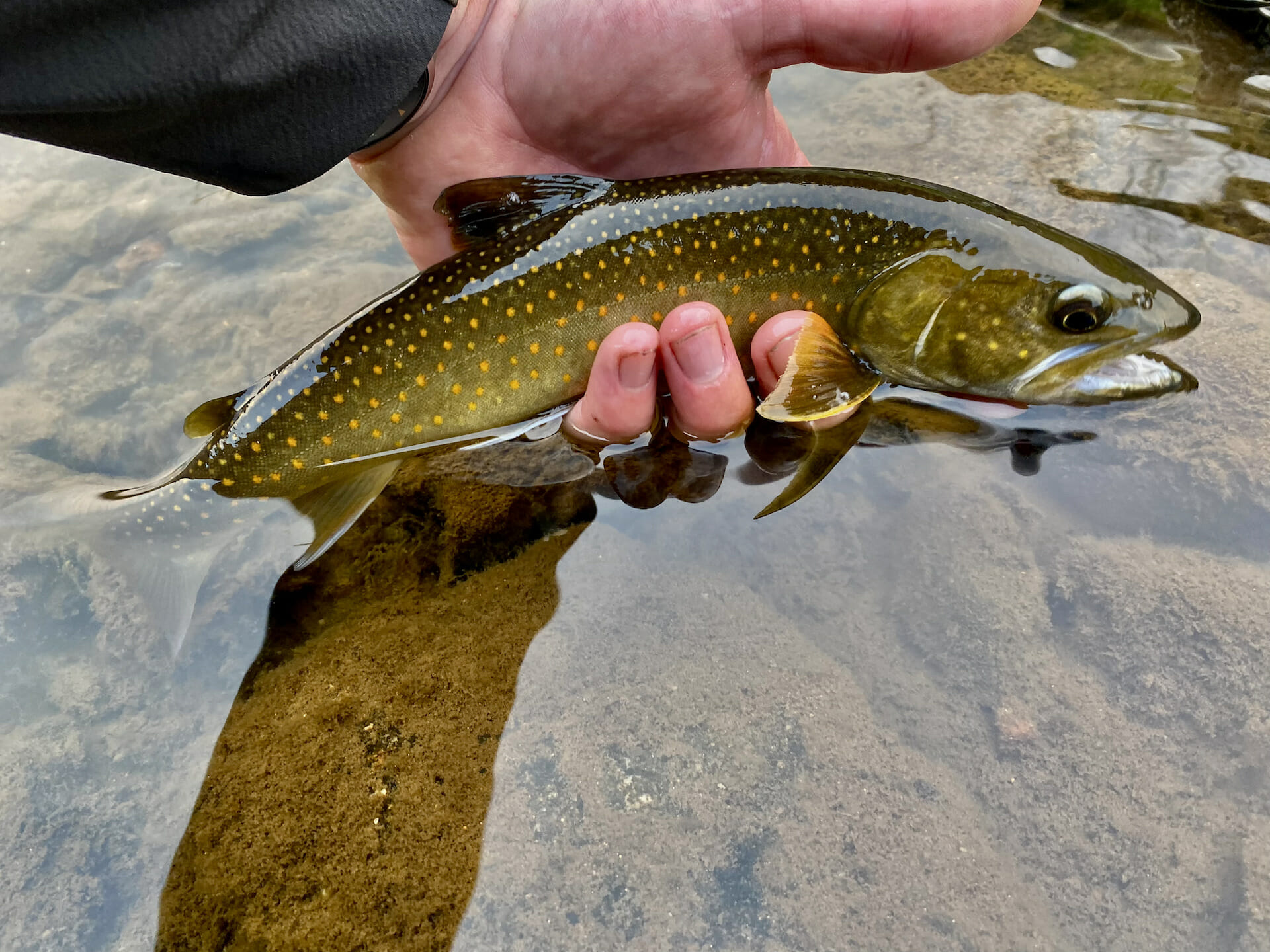Bull trout (Salvelinus confluentus)
Species summary and status: The bull trout was once found throughout the Columbia River Basin, east to western Montana, south to northern Nevada, west to California and possibly as far north as southeastern Alaska. The main populations remaining in the lower 48 states are in Montana, Idaho, Oregon, and Washington, with a small population in northern Nevada.
The bull trout has small, pale yellow-to-crimson spots on a darker background, fading to white on the belly. Bull trout and Dolly Varden look very similar, and were once considered the same species. Both have small, pale yellow to crimson spots on a darker background, which ranges from olive green to brown above, fading to white on the belly. Spawning adults develop varying amounts of red on the belly. Both species also exhibit differences in size, body characteristics, coloration, and life history behavior across their range.Taxonomic work, published in 1978 and accepted by the American Fisheries Society in 1980, identified bull trout as distinct from the Dolly Varden. Compared to Dolly Varden, bull trout are larger on average, with a relatively longer and broader head. Bull trout are mainly an inland species, while Dolly Varden are more common in coastal areas. In Washington, both species are present in the Puget Sound area.
Small bull trout eat terrestrial and aquatic insects but shift to preying on other fish as they grow larger. Large bull trout are primarily fish predators. Bull trout evolved with whitefish, sculpins and other trout and use all of them as food sources.
Bull trout reach sexual maturity between four and seven years of age and are known to live as long as 12 years. They spawn in the fall after temperatures drop below 48° Fahrenheit (8°C), in streams with cold, unpolluted water, clean gravel and cobble substrate, and gentle stream slopes. Many spawning areas are associated with cold water springs or areas where stream flow is influenced by groundwater. Bull trout eggs require a long incubation period compared to other salmon and trout (4-5 months), hatching in late winter or early spring. Juvenile fish retain their fondness for the stream bottom and are often found at or near it.
Some bull trout may live near areas where they were hatched. Others migrate from streams to lakes, reservoirs (or, in the case of coastal populations, salt water) a few weeks after emerging from the gravel. Migratory bull trout attain a greater size than resident stream fish. However, lakes and reservoirs are not good spawning habitat, so migratory bull trout may swim considerable distances to spawn when habitat conditions allow. For instance, bull trout in Montana’s Flathead Lake have been known to migrate up to 155 miles (250 km) to spawn. Migration is important to maintaining healthy bull trout populations.
The U.S. Fish and Wildlife Service (Service) announced Sept. 4, 2014, the availability of a Revised Draft Recovery Plan for the Coterminous U.S. Population of Bull Trout. Bull trout are listed as threatened under the Endangered Species Act in the lower 48 United States. It occurs in Montana, Idaho, Washington, Oregon, and Nevada. The Service recently published a Final Recovery Plan for the Coterminous U.S. Population of Bull Trout on Sept. 30, 2015.
Looking forward: Although bull trout are widely distributed over a large geographic area, the effects of human activities over the past century have reduced their overall distribution and particularly their abundance. Increased habitat fragmentation from dams, diversions, land and water management practices, and human development has reduced the amount of available connected habitat. Increased isolation of local populations and decreased connectivity between bull trout Core Areas is resulting in a loss o f the migratory life forms of bull trout and is a major concern for population viability. Bull trout tend to be more migratory than other western native trout. Fish passage along migration routes that connect foraging, migrating, and over‐ wintering habitat with spawning tributaries are crucial to bull trout life history and maintaining sufficient genetic variability. Fragmentation, isolation, and the resulting inability for local populations and Core Areas to exchange individuals and genetics remains a potential obstacle to population viability.
Loss of habitat quality has been recognized as one of the two major human influences in the loss of bull trout populations across the west.
It is well documented that introduced populations of brook trout and lake trout often become established and threaten bull trout, likely through the primary mechanisms of competition and predation. In the case of brook trout , hybridization is also an added factor. Hybridization between brook trout and bull trout results in offspring that are frequently sterile
At present, there are multiple State, Federal, Tribal, private, and Canadian conservation efforts to improve the status of bull trout in the northwestern United States and Canada. Project implementation has generally followed a site‐specific and opportunity‐based approach, rather than a watershed‐based approach, with varied results and accomplishments. With two nations, five states, multiple federal agencies, and numerous Tribal nations involved, it has been difficult to discern a coordinated or prioritized basis for bull trout restoration and habitat status.
All data compiled from:



